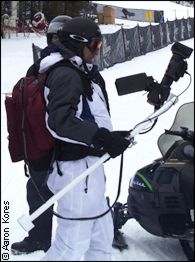 Not all cameramen are created equal Not all cameramen are created equal
by Daniel Dodd, ESPN.com
MOUNT SNOW, Vt. -- Ever since the first X Games took place in Rhode Island in 1995, ESPN has been known for its "extreme" coverage of the event to go along with the "extreme" sports taking place. Whether it's a camera attached to a street luger's helmet or a bird's-eye view of a skysurfer taking flight, the viewer can literally feel the competition as it's taking place.
|  | | It's all about getting the best shot possible. |
At the Winter X Games 2000 in Mount Snow, it's business as usual as viewers are getting a first-hand account of what its like to compete in the Games.
And it might not be as hi-tech as you think.
Enter Jeff Silverman and Scott Kilian -- one-third of America's population of chase-cam operators.
"There are about five or six guys in the country who do a lot of chase-cam and pretty much five of them are here," says veteran chase-cam operator Jeff Silverman.
Chase-cam is exactly that. A cameraman, on skis, chasing the athlete down the hill complete with a rounded bar that looks like a walker that your great-grandmother might use, and a camera attached to the front. An elongated lens allows the operator to see the shot without moving his head, allowing him to concentrate on the myriad of prompts he is being given.
"We're listening to the director. We're being controlled by the truck. And we are tying to frame in the same manner as every other camera is," says Silverman. "We're tying to negotiate the course and avoid athletes who have a mind of their own in terms of where they are going to go."
"A feature of Slopestyle is that they can go wherever they want but we don't know where they are going to go. It's a guessing game."
And if they don't guess right, it could be disastrous.
"We're trying to make sure the equipment is working and trying to outguess some rider who might fall and look at us and say 'Oh geez, you were right in my way.' We can't let that happen," says Silverman.
But trying to stay out of the way also coincides with trying to get the best shots possible.
"I try to stay as close as possible before I think I'm going to upset the athlete," says Silverman. "All of us try to choreograph our moves like starting on one side of the rider and swinging around and changing up the background. We try to make it a little more interesting instead of just following them."
But the chase-cam isn't the only camera on the slope, as was the case in Thursday's men's and women's Snowboard Slopestyle finals. A long crane with a camera attached was also used to get wide angle shots of the rider as he or she was flying down the hill. Because the camera is parallel to the athlete, it poses a danger for the chase-cam operator.
"One of the big challenges on this course is you have this 75-foot Stratocrane that's stretched out right across the deck," says fellow chase-cam operator Scott Kilian. "You're coming over this hill going very fast and 90 percent of the time that crane is about eight feet off the ground. So we duck as we go under it and put on the brakes so we don't get in front of the competitor. You process a lot of information really fast."
But it's that fast pace and unpredictability that makes it so appealing for these guys.
"To tell you the truth, that's why I do it. I would get pretty bored doing the normal hard camera," says Silverman. "This is much more work. We don't get paid much more than a regular camera man, but I still do it and I still really enjoy it."
And why not, he's even got his own fan club.
"A lot of people a lot of times will both cheer for us and cheer against us. Even at the first X Games I had people taking my picture and asking for my autograph. I told them you really don't want my picture. All I do is ski with a camera."
If you want to see what Silverman sees, you can. He aided in ESPN.com's 360 degree webcam that allows users to "Take a run with an X Games athlete." Silverman wore a special lens while "chasing" the athlete so you can get a birds eye view of Barrett Christy, J.P. Walker and others.
If you are wondering, yes, to be a chase-cam operator you not only have to be a good skier, but an excellent skier.
"I think we all pretty much have racing backgrounds," says Silverman.
"I have a racing background from college," says Kilian. "I've got probably 35 years of skiing under me."
Silverman couldn't help but laugh.
"Wow, I'm only 34 and I have 32 years experience!" says Silverman.
|
